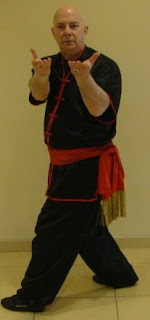by Phillip Starr
One morning, Ohshima arrived to find his sensei sitting up on the edge of his bed and practicing the basic seiken-tsuki (forefist thrust). Funakoshi looked over at his student and said, “I think I've finally got it!” This humble man had never spoken of his great skill before. Ohshima wept. Funakoshi passed away a few days later.
Kofujita Kangejuzaemon Toshinao was a master swordsman of feudal Japan who devoted his entire life to mastery of his art. Although he began in the style of the Chujo ryu, he was later accepted into the dojo of Itto Ittosai Kagehisa, who founded the famed Itto (“One Sword”) style of swordsmanship. The primary tactic of this school required a fine sense of timing and total confidence in one's ability to execute a single blow at precisely the right moment. Kofujita took to this concept with great enthusiasm.
He became a recognized master and authority of the art and was titled a “shihan” (“a model for all others”). One day as he was in his garden practicing, an old classmate visited him. His friend stood inside the house and quietly watched so as not to disturb the master. He saw that Kofujita was practicing a basic exercise of using his hips to precede the action of cutting. This was the very first thing that Itto-ryu novices were taught. The aging classmate could see that his old friend was wholly focused on the technique.
After a short time, Kofujita saw his friend and realized the classmate had tears in his eyes. “it is the first thing our master taught us”, Kofujita said. “I don't think it's quite good enough yet, do you?”
Kofujita's introspection and incessant struggle to examine his own progress, reflect on it, and strive for improvement (no matter how long he'd practiced it) is characteristic of a master. In Japanese, this attitude is called “ryomi”...intense, ongoing, self-evaluation.
In contemporary martial arts, the title of “traditionalist” is given to those who practice the ways of the past. You won't find them wearing glitzy uniforms or strutting around at tournaments with their chests puffed out. They're on a journey of self-discovery – which would be frustrated by following current fads. They believe in what they do and can be quite obstinate. Many regard them as people who see themselves as faultless paragons, paladins of the Way of the warrior. Traditionalists rarely challenge this view while they engage in self-citicism only in secrecy and amongst their own kind. It's a fault for which they must be forgiven.
Self-criticism is not pleasant nor easy to do. The main reason is that the arts that they follow far exceed the more modern “eclectic” forms. A second reason is that the criticisms of their art are often offered by those who are quite ignorant; one self-appointed critic may ask “what has all this practice of forms got to do with real fighting?” Such ones might just as well ask an auto mechanic what possible value a drive shaft could have in making a car go...
The overall problem faced by traditionalists is that although their world is filled with excellence, it is usually too small and often extends only to the walls of his dojo. This can foster rather narrow views. But there's nothing at all wrong with spending time in the schools of other accomplished martial artists, asking questions, and getting to know other traditionalists. This is actually following a very old and valuable custom of the martial arts.
Some traditionalists come to see themselves as purists, fine examples of their arts, and faultless. They are wrong. And if a master like Kofujita and Gishin could submit themselves to the self-criticism of ryomi, then today's practitioners could survive and even benefit from a little of the same.








.jpg)
.jpg)
.jpg)
.jpg)


.jpg)
.jpg)
.jpg)


























.jpg)
.jpg)





















